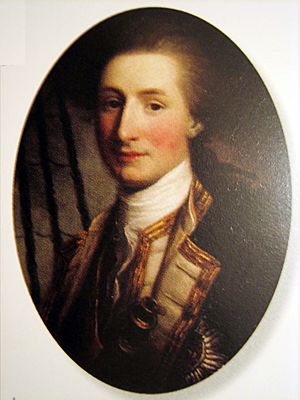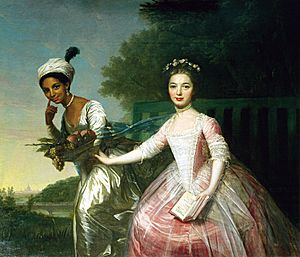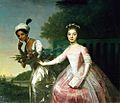Dido Elizabeth Belle facts for kids
Quick facts for kids
Dido Elizabeth Belle
|
|
|---|---|

Painting of Belle (cropped), David Martin
|
|
| Born | June 1761 |
| Died | July 1804 (aged 42–43) London, England
|
| Resting place | St George's Fields, Westminster (1804–1970s) |
| Nationality | British |
| Occupation | Heiress |
| Spouse(s) |
Jean Louis Charles Davinière
(m. 1793) |
| Children | 3 |
| Parent(s) |
|
| Relatives |
|
Dido Elizabeth Belle (born June 1761 – died July 1804) was a special British heiress. She was part of the important Lindsay family. Dido was born into slavery in the British West Indies. Her mother, Maria Belle, was an enslaved African woman. Her father was Sir John Lindsay, a British naval officer.
Sir John Lindsay brought Dido to England in 1765. He asked his uncle, William Murray, 1st Earl of Mansfield, and his wife, Elizabeth Murray, to raise her. The Murrays lived at Kenwood House. They educated Dido and raised her as a free gentlewoman. She grew up with her cousin, Lady Elizabeth Murray. Dido lived at Kenwood House for 30 years. When Lord Mansfield died, he left her money. This made her an heiress.
Contents
Dido's Early Life

Dido Elizabeth Belle was born in 1761. This was in the British West Indies. Her mother was an enslaved African woman named Maria Belle. Her father was Sir John Lindsay. He was a naval officer and captain of the British warship HMS Trent.
Sir John Lindsay brought young Dido to London in 1765. He took her to Kenwood House. This was the home of his uncle, Lord Mansfield, and his wife. Dido was baptized in 1766. The Murray family raised Dido like their own child. She grew up with her cousin, Lady Elizabeth Murray.
A newspaper article about Sir John Lindsay mentioned Dido. It said he had a daughter who was "brought up in Lord Mansfield's family." It also said she was kind and well-liked.
Life at Kenwood House
Lord and Lady Mansfield lived at Kenwood House in Hampstead, near London. They had no children of their own. They were already raising their great-niece, Lady Elizabeth Murray. Dido and Elizabeth grew up together.
Dido was treated like a family member when they were alone. She helped Lord Mansfield with his letters as he got older. This showed she was well-educated.
One of Lord Mansfield's friends, Thomas Hutchinson, visited Kenwood House. He wrote in his diary about Dido. He said she was very helpful to Lord Mansfield. He also mentioned that Dido joined the ladies after dinner. This was unusual for someone born into slavery.
Lord Mansfield was a very important judge. He made a big decision about slavery in 1772. This was in a case called Somerset v Stewart. A slave named James Somerset had escaped. His owner wanted to send him back to the West Indies. Lord Mansfield ruled that slavery was not allowed by English law. This meant that slaves in England could not be forced back into slavery. Many people believe Dido's presence influenced his decision.
Dido's Place in Society
Dido's position in the family was quite special. It was very rare for a mixed-race child to be raised in an aristocratic British family. She was treated well, but sometimes differently. For example, she did not always eat dinner with guests. However, she had expensive medical care and nice things for her room. This showed she was important to the family.
As Dido got older, she helped manage the farm at Kenwood. She also helped her uncle with his letters. This was usually done by a male secretary. Dido received an allowance of £30 10 shillings each year. Her cousin, Lady Elizabeth, received more money. Dido was also born outside of marriage, which carried a social stigma at the time.
To compare, a housekeeper in a rich home earned about £20 to £70 a year. A naval officer earned about £100 a year. So, Dido's allowance was a good amount for the time.
Later Years and Family
Dido's father, Sir John Lindsay, died in 1788. He left money to his children, including Dido. Lord Mansfield made sure Dido would be free after his death. In his will, he left her £500 and an annual payment of £100.
After Lord Mansfield died in 1793, Dido got married. She married Jean Louis Charles Davinière in London. He was from France. They had at least three sons: Charles, John, and William Thomas.
Dido died in 1805 when she was 43 years old. She was buried in London. Her husband later remarried.
Dido's Descendants
Two of Dido's sons, William Thomas and Charles, worked for the East India Company. This was a very powerful British trading company. William worked in England, and Charles worked in India. They likely had a good education.
Charles Davinière joined the army in 1811. He served in India. He became a captain and later a major. He retired in 1845. Charles married Hannah Nash and lived in London. He died in 1873.
William Thomas Davinière married a widow named Fanny Graham. They had a daughter named Emily. Emily died unmarried in 1870.
Dido's last known descendant, Harold Davinier, died in South Africa in 1975. He had no children.
Dido in Art and Stories
18th-century Portrait Painting
The Mansfield family had a painting made of Dido and Elizabeth. It was finished in 1779. The painting is special because it shows a Black woman and a White woman as almost equals. It shows Dido next to her cousin Elizabeth. Dido is carrying exotic fruit and wearing a turban with an ostrich feather. The painting is now at Scone Palace in Scotland.
Film, Music, and Plays
Dido's life has inspired many creative works:
- Dido Belle (2006) is a short film about her life.
- Shirley J. Thompson wrote an opera about Dido. It was performed in London in 2007.
- A play called An African Cargo (2007) featured Dido. It was about a terrible event called the Zong massacre. Dido's character spoke about the injustice of slavery.
- Let Justice Be Done (2008) is a play that explored Dido's possible influence on Lord Mansfield's ruling about slavery.
- The movie Belle (2013) tells Dido's story. It shows her life as a mixed-race heiress in 18th-century England. The film stars Gugu Mbatha-Raw as Dido.
- I, Dido (2018) is a play about Dido, Lord Mansfield, and Lady Betty. It has also been made into a short film.
Novels
- Family Likeness (2013) by Caitlin Davies was partly inspired by Dido's life.
- Paula Byrne wrote Belle: The True Story of Dido Belle (2014). This book was released with the movie Belle.
- Zadie Smith mentions Dido in her 2016 novel Swing Time.
- The short story "Dido" by Emma Donoghue is about Dido Elizabeth Belle.
- Dido Elizabeth Belle is a main character in The Lizzie and Belle Mysteries: Drama and Danger (2022). This children's book series imagines her friendship with Elizabeth Sancho.
Images for kids
See also
 In Spanish: Dido Elizabeth Belle para niños
In Spanish: Dido Elizabeth Belle para niños
- Black British nobility, the class that Belle belonged to.





